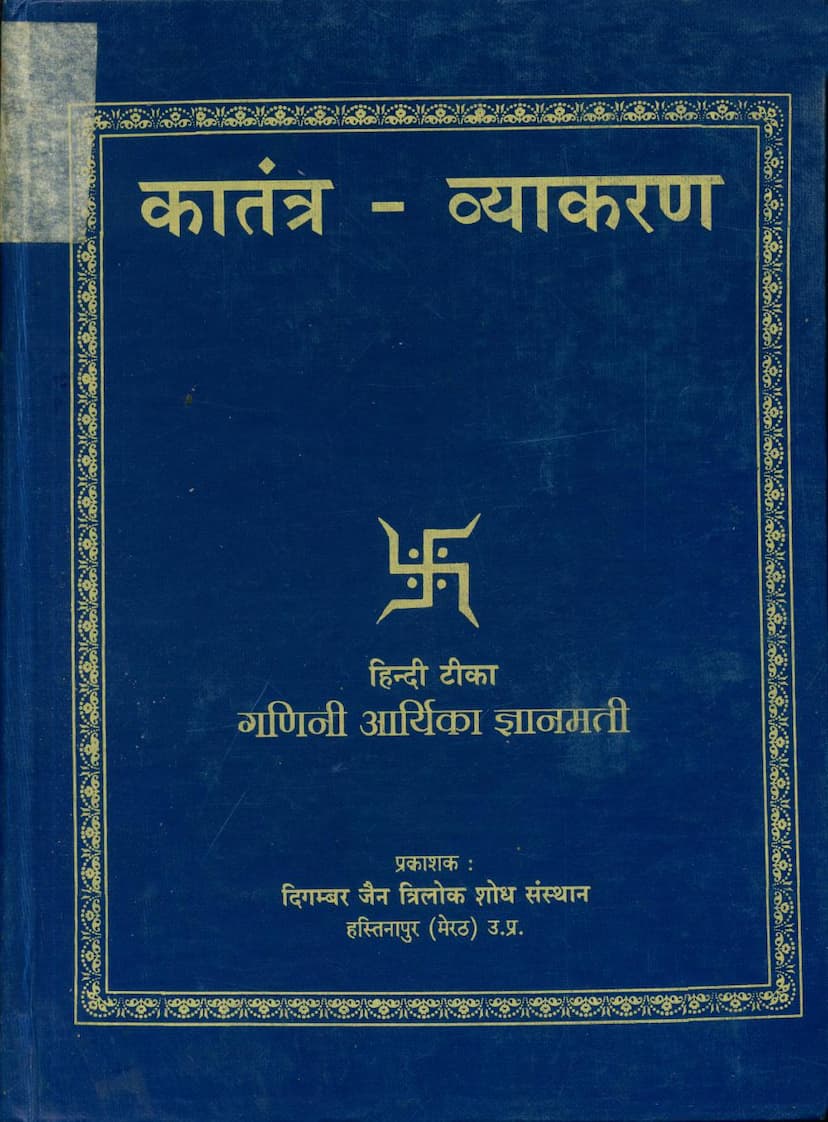Katantra Vyakaran
Added to library: September 2, 2025

Summary
Here's a comprehensive summary of the Jain text "Katantra Vyakaran" by Gyanmati Mataji, based on the provided pages:
Title: Katantra Vyakaran (with Hindi commentary)
Author: Gani Aryika Gyanmati Mataji (based on the original Sanskrit work of Shrivarmacharya, with Sanskrit commentary by Shrimad Bhavasenacharya)
Publisher: Digambar Jain Trilok Shodh Sansthan, Hastinapur (Meerut), U.P.
Series: Veer Gyanodaya Granthamala, Pushpa No. 83
Overall Purpose and Nature of the Text:
This book is a detailed presentation of the Katantra Vyakaran, a Sanskrit grammar, along with a Hindi commentary and translation by Aryika Shiromani Shri Gyanmati Mataji. The text aims to make the study of Sanskrit grammar accessible and understandable, particularly within the Jain tradition. It highlights the importance of grammar for understanding religious and philosophical texts and emphasizes the grammatical tradition within Jainism.
Key Features and Content:
-
Original Work and Commentary: The book is based on the "Kalap Vyakarana" composed by Shrvavarmacharya. "Katantra Rupmala" is a commentary on this grammar by Shrimad Bhavasen, who is described as a "Vadi Parvat Vajra" (a diamond against the mountain of debaters) and a "Traividya" (master of grammar, logic, and philosophy). Gyanmati Mataji's contribution is the Hindi translation and commentary, making the complex grammatical rules accessible to a wider audience.
-
Simplicity and Accessibility: The text emphasizes that Katantra Vyakaran is a concise and simple grammar, intended for "Bal Bodh" (understanding for children) or those unfamiliar with the science of words. Its clear style led to its propagation not only in India but also abroad, including Central Asia where Buddhist monasteries used it for teaching Sanskrit.
-
Structure of Katantra Vyakaran:
- The grammar is divided into two parts: Purvardha (first part) and Uttarardha (second part).
- The Purvardha contains 574 sutras covering Sandhi (euphony), Nama-praticpadika (noun stems), Samas (compounds), and Taddhita (secondary suffixes).
- The Uttarardha contains 809 sutras covering Tinanta (verb conjugations) and Kridanta (verbal roots).
- The total number of sutras is 1483.
-
Gyanmati Mataji's Personal Journey and Inspiration: Page 7-9 provide a significant insight into Gyanmati Mataji's personal dedication and exceptional ability in learning Sanskrit grammar. Her strong desire for knowledge, even leading to tears when facing obstacles, is described. Her teachers recognized her talent, calling her "Vyatpanna Mati" (one with profound intellect). The story highlights her ability to grasp complex grammatical rules quickly, even remembering them in dreams, and the fact that she completed the two-year course in just two months. This personal account underscores the author's deep connection to the subject and her dedication to spiritual knowledge.
-
Comparison with Panini's Grammar: The text draws a comparison with Panini's grammar, noting that Panini's grammar, with its "Pratyahara" system, is considered difficult. Katantra Vyakaran, in contrast, is seen as more accessible and natural, making it appealing to Jain acharyas and others outside the Vedic tradition. The book also suggests that Katantra Rupmala's structure and the number of forms it explains are more extensive than even some popular modern grammars like "Laghu Siddhanta Kaumudi."
-
Contribution of Jain Scholars: The text mentions that Sanskrit studies within the lineage of Acharya Shri 108 Vir Sagarji Maharaj were based on Katantra Vyakaran. It names several prominent Jain scholars, including Acharya Jnanasagarji, Muni Ajitsagarji, Acharya Vidyasagarji, and Aryika Jaimati Mataji herself, as having benefited from this grammar.
-
Historical and Cultural Context: The book touches upon the foreign propagation of Katantra Vyakaran, suggesting its importance in the ancient world. It also mentions its presence in Rajasthani Jain scriptoriums, indicating its widespread use and transmission.
-
Emphasis on Jain Principles: The publication is under the "Veer Gyanodaya Granthamala," dedicated to nurturing the "Arsh Marg" (path of the ancients) of the Digambar Jain tradition. The text implicitly connects grammatical knowledge to spiritual progress and the attainment of liberation.
-
Publisher's Mission: The Digambar Jain Trilok Shodh Sansthan's mission is to publish scholarly works that support the Jain tradition in various languages, covering subjects like logic, philosophy, spirituality, geography, astronomy, and grammar.
-
Appendices and Indexes: The table of contents (Page 6) indicates various appendices and indexes, including:
- Lists of Dhatus (verb roots) categorized into various ganas (groups like Bhuadi, Juhotyadi, Divadi, etc.).
- Kridanta Prakaran (section on verbal roots).
- Taddhita Prakaran (section on secondary suffixes).
- Samas Prakaran (section on compounds).
- Index of verses.
- List of definitions.
- List of one-syllable words (Ekakshari Kosh).
-
Detailed Grammatical Concepts: The latter part of the provided text dives into specific grammatical rules, covering:
- Sangya Sandhi: Introduction to phonetic rules.
- Svara Sandhi: Rules for vowel combinations.
- Vyanjana Sandhi: Rules for consonant combinations.
- Prakriti Bhava Sandhi: Rules for maintaining the natural state of sounds.
- Visargiya Sandhi: Rules related to visarga (:) sound.
- Lingodbhava: Discussion of gender for nouns.
- Vibhaktis: Detailed explanation of case endings and their application to nouns.
- Taddhita: Explanation of secondary suffixes.
- Kridanta: Explanation of verbal roots and their derivatives.
- Samas: Detailed coverage of compound formation.
- Avyaya: Explanation of indeclinable words.
- Pratyaya: Discussion of suffixes.
- Tinganta: Discussion of verb conjugations and their various forms across tenses and moods (e.g., Vartamana, Saptami, Panchami, Hyastani, Adyatani, Paroksha, Shvastani, Ashi, Bhavishyati, Kriyatipattti).
Significance:
The "Katantra Vyakaran" by Gyanmati Mataji serves as a valuable resource for anyone seeking to learn Sanskrit grammar, especially within the Jain context. It is a testament to the author's vast scholarship and dedication to making ancient knowledge accessible. The book not only teaches grammar but also provides glimpses into the rich intellectual heritage of Jainism and the profound commitment of its scholars to learning and spiritual upliftment. The publisher's efforts in bringing out this work contribute significantly to the preservation and dissemination of Jain literature and learning.